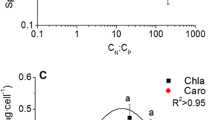Abstract
Phaeocystis pouchetii (Hariot) Lagerheim is widely distributed in polar waters, and forms massive near-surface blooms in the marginal ice-edge zone around Antarctica during spring and summer. UV irradiance in the Antarctic marine environment is reportedly as high in October and November as in mid-summer due to stratospheric ozone depletion. Because of the location and timing of theP. pouchetii bloom, this prymnesiophyte will be exposed to high levels of UV-B (280 to 320 nm) radiation. Colourless water-soluble compounds, produced by the colonial stage in the life cycle of this alga, absorb strongly between 250 and 370 nm, with absorbance maxima at 271 and 323 nm. The concentration of these compounds in culturedP. pouchetii depends on the strain, stage in the life cycle, and presence of bacteria. As well as conferring substantial protection to this alga, these substances may also provide UV protection to other organisms present in the water column.
Similar content being viewed by others
Literature cited
Caldwell, M. M. (1981). Plant responses to solar ultraviolet radiation. In: Lange, O. L., Nobel, P. S., Osmond, C. B., Ziegler, H. (eds.) Encyclopedia of plant physiology. New series. Physiological plant ecology. 1. Springer-Verlag, New York, p. 169–197
Calkins, J., Thordardottir, T. (1980). The ecological significance of solar UV radiation on aquatic organisms. Nature, Lond. 283: 563–566
Carreto, J. I., Carignan, M. O., Daleo, G., De Marco, S. G. (1990). Occurrence of mycosporine-like amino acids in the red-tide dinoflagellateAlexandrium excavatum: UV-photoprotective compounds? J. Plankton Res. 12: 909–921
Davidson, A. T., Marchant, H. J. (1987). Binding of manganese by AntarcticPhaeocystis pouchetii and the role of bacteria in its release. Mar. Biol. 95: 481–487
Davidson, A. T., Marchant, H. J. (1991). Protist interactions and carbon concentration during aPhaeocystis-dominated bloom at an Antarctic coastal site. (in preparation)
Dunlap, W. C., Chalker, B. E., Oliver, J. K. (1986). Bathymetric adaptations of reef-building corals at Davies Reef, Great Barrier Reef, Australia. III. UV-B absorbing compounds. J. exp. mar. Biol. Ecol. 104: 239–248
Dunlap, W. C., Williams, D. McB., Chalker, B. E., Banaszak, A. T. (1989). Biochemical photoadaptation in vision; U.V.-absorbing pigments in fish eye tissues. Comp. Biochem. Physiol. 93B: 601–607
Frederick, J. E., Snell, H. E. (1988). Ultraviolet radiation levels during the antarctic spring. Science, N.Y. 241: 438–440
Fryxell, G. A., Kendrick, G. A. (1988). Austral spring microalgae across the Weddell Sea ice edge; spatial relationships found along a northward transect during AMERIEZ 83. Deep-Sea Res. 35: 1–20
Garrison, D. L., Buck, K. R., Fryxell, G. A. (1987). Algal assemblages in the antarctic pack ice and in ice-edge plankton. J. Phycol. 23: 564–572
Hardy, J., Gucinski, H. (1989). Stratospheric ozone depletion: implications for marine ecosystems. Oceanography, Wash. 2: 18–21
Jacka, T. H. (1983). A computer data base for Antarctic sea ice extent. A.N.A.R.E. Res. Notes 13: 1–54
Jerlov, N. G. (1950). Ultra-violet radiation in the sea. Nature, Lond. 166: 111–112
Loeblich, A. R. III, Smith, V. E. (1968). Chloroplast pigments of the marine dinoflagellateGymnodinium resplendens. Lipids 3: 3–15
Lorenzen, C. J. (1967). Determination of chlorophylla and phaeopigments: spectrophotometric equations. Limnol. Oceanogr. 12: 343–347
Maske, H. (1984). Daylight ultraviolet radiation and the photoinhibition of phytoplankton carbon uptake. J. Plankton Res. 6: 351–357
Roberts, L. (1989). Does the ozone hole threaten antarctic life? Science, N.Y. 244: 288–289
Scherer, S., Chen, T. W., Böger, P. (1988). A new UV-A/B protecting pigment in the terrestrial cyanobacteriumNostoc commune. Pl. Physiol. 88: 1055–1057
Shibata, K. (1969). Pigments and UV-absorbing substance in corals and a blue-green alga living in the Great Barrier Reef. Pl. Cell Physiol., Kyoto 10: 325–335
Sieburth, J. McN. (1960). Acrylic acid, an “antibiotic” principle inPhaeocystis blooms in Antarctic waters. Science, N.Y. 132: 676–677
Sivalingam, P. H., Ikawa, T., Yokohama, Y., Nisizawa, K. (1974). Distribution of 334 UV-absorbing-substances in the algae, with special regard of its possible physiological roles. Botanica mar. 17: 23–29
Smith, R. C., Baker, K. S. (1979). Penetration of UV-B and biologically effective dose-rates in natural waters. Photochem. Photobiol. 29: 311–323
Smith, R. C., Baker, K. S. (1989). Stratospheric ozone, middle ultraviolet radiation and phytoplankton productivity. Oceanography, Wash. 2: 4–10
Smith, W. O., Jr. (1987). Phytoplankton dynamics in marginal ice zones. Oceanogr. mar. Biol. A. Rev. 25: 11–38
Verity, P. G., Villareal, T. A., Smayda, T. J. (1988). Ecological investigations of blooms of colonialPhaeocystis pouchetii — I. Abundance, biochemical composition, and metabolic rates. J. Plankton Res. 10: 219–248
Vincent, W. F. (1988). Microbial ecosystems of Antarctica. Cambridge University Press, Cambridge
Voytek, M. A. (1990). Addressing the biological effects of decreased ozone on the Antarctic environment. Ambio 19: 52–61
Wood, W. F. (1989). Photoadaptive responses of the tropical red algaEucheuma striatum Schmitz (Gigartinales) to ultra-violet radiation. Aquat. Bot. 33: 41–51
Worrest, R. C. (1983). Impact of solar ultraviolet-B radiation (290–320 nm) upon marine microalgae. Physiologia Pl. 58: 428–434
Wright, S. W., Shearer, J. D. (1984). Rapid extraction and high performance liquid chromatography of chlorophylls and carotenoids from marine phytoplankton. J. Chromat. 294: 281–296
Yentsch, C. S., Yentsch, C. M. (1982). The attenuation of light by marine phytoplankton with special reference to the absorption of near-UV radiation. In: Calkins, J. (ed.) The role of solar ultraviolet radiation in marine ecosystems. Plenum, New York, p. 691–706
Zar, J. H. (1984). Biostatistical analysis. 2nd ed. Prentice-Hall, New Jersey
Author information
Authors and Affiliations
Additional information
Communicated by G.F. Humphrey, Sydney
Rights and permissions
About this article
Cite this article
Marchant, H.J., Davidson, A.T. & Kelly, G.J. UV-B protecting compounds in the marine algaPhaeocystis pouchetii from Antarctica. Mar. Biol. 109, 391–395 (1991). https://doi.org/10.1007/BF01313504
Accepted:
Issue Date:
DOI: https://doi.org/10.1007/BF01313504



